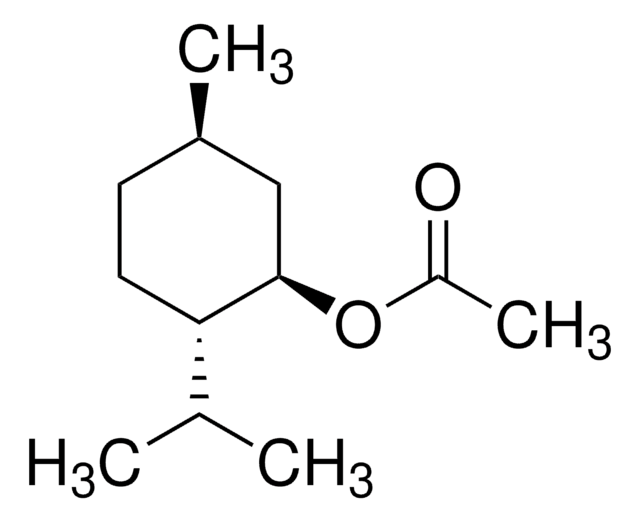Key Documents
16254
Thymol
meets analytical specification of Ph. Eur., BP, NF, 99-101%
Synonim(y):
2-Isopropyl-5-methylphenol, 5-Methyl-2-(1-methylethyl)phenol, 5-Methyl-2-isopropylphenol, IPMP
About This Item
Polecane produkty
ciśnienie pary
1 mmHg ( 64 °C)
Poziom jakości
Próba
99-101%
Postać
solid
jakość
meets analytical specification of Ph. Eur., BP, NF
zanieczyszczenia
acidic reac. impurities, complies
organic volatile impurities, complies (GC)
related subst., complies (GC)
residual solvents, complies
≤0.05% non-volatile matter
tw
232 °C (lit.)
mp
48-51 °C (lit.)
48-51 °C
gęstość
0.965 g/mL at 25 °C (lit.)
przydatność
complies for appearance of solution
ciąg SMILES
CC(C)c1ccc(C)cc1O
InChI
1S/C10H14O/c1-7(2)9-5-4-8(3)6-10(9)11/h4-7,11H,1-3H3
Klucz InChI
MGSRCZKZVOBKFT-UHFFFAOYSA-N
Szukasz podobnych produktów? Odwiedź Przewodnik dotyczący porównywania produktów
Zastosowanie
- the effect of thymol on the viability of Bacillus cereus.
- its effect on growth and production of citrinin from Penicillium citrinum.
- the effect of thymol on insect and human γ-aminobutyric acid (GABA) receptors.
Działania biochem./fizjol.
Oświadczenie o zrzeczeniu się odpowiedzialności
Hasło ostrzegawcze
Danger
Zwroty wskazujące rodzaj zagrożenia
Zwroty wskazujące środki ostrożności
Klasyfikacja zagrożeń
Acute Tox. 4 Oral - Aquatic Chronic 2 - Eye Dam. 1 - Skin Corr. 1B
Kod klasy składowania
8A - Combustible corrosive hazardous materials
Klasa zagrożenia wodnego (WGK)
WGK 2
Temperatura zapłonu (°F)
240.8 °F - closed cup
Temperatura zapłonu (°C)
116 °C - closed cup
Środki ochrony indywidualnej
dust mask type N95 (US), Eyeshields, Faceshields, Gloves, type P3 (EN 143) respirator cartridges
Wybierz jedną z najnowszych wersji:
Masz już ten produkt?
Dokumenty związane z niedawno zakupionymi produktami zostały zamieszczone w Bibliotece dokumentów.
Klienci oglądali również te produkty
Bacillus cereus Heat-Treated Vegetative Cells
Nasz zespół naukowców ma doświadczenie we wszystkich obszarach badań, w tym w naukach przyrodniczych, materiałoznawstwie, syntezie chemicznej, chromatografii, analityce i wielu innych dziedzinach.
Skontaktuj się z zespołem ds. pomocy technicznej









